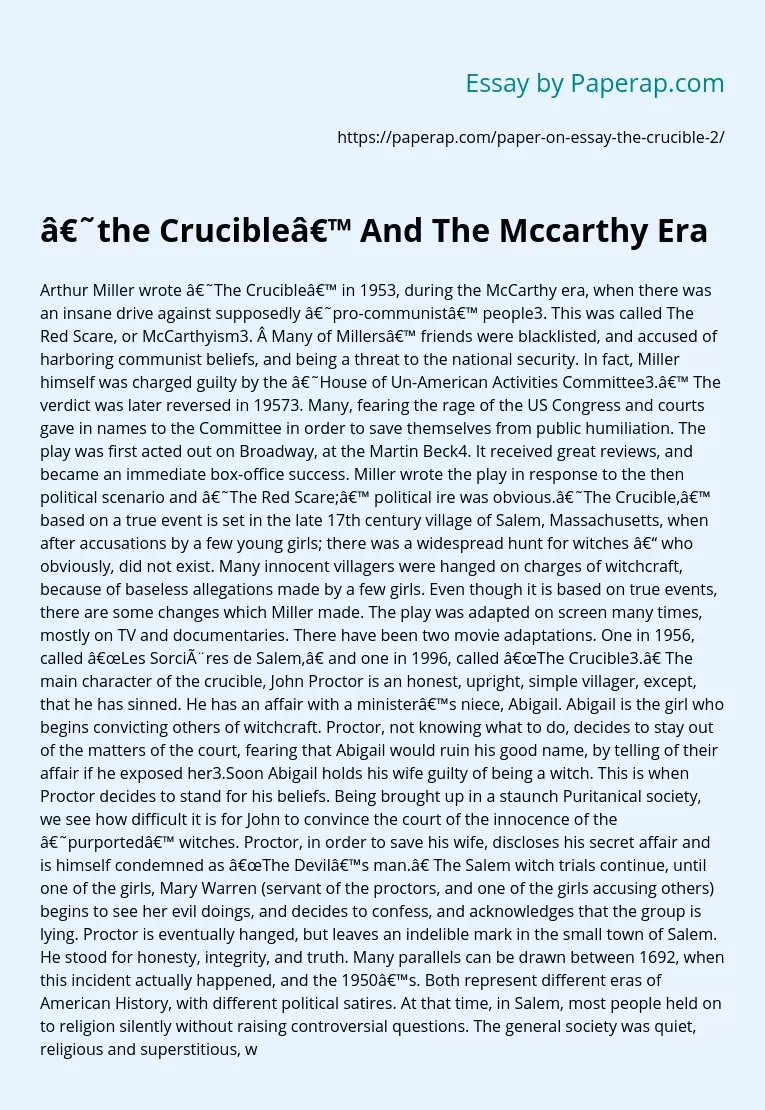"The Crucible" by Arthur Miller And The Mccarthy Era
Arthur Miller wrote ‘The Crucible’ in 1953, during the McCarthy era, when there was an insane drive against supposedly ‘pro-communist’ people3. This was called The Red Scare, or McCarthyism3. Many of Millers’ friends were blacklisted, and accused of harboring communist beliefs, and being a threat to the national security. In fact, Miller himself was charged guilty by the ‘House of Un-American Activities Committee3.’ The verdict was later reversed in 19573. Many, fearing the rage of the US Congress and courts gave in names to the Committee in order to save themselves from public humiliation.
The play was first acted out on Broadway, at the Martin Beck4.
It received great reviews, and became an immediate box-office success. Miller wrote the play in response to the then political scenario and ‘The Red Scare;’ political ire was obvious.‘The Crucible,’ based on a true event is set in the late 17th century village of Salem, Massachusetts, when after accusations by a few young girls; there was a widespread hunt for witches – who obviously, did not exist.
Many innocent villagers were hanged on charges of witchcraft, because of baseless allegations made by a few girls. Even though it is based on true events, there are some changes which Miller made. The play was adapted on screen many times, mostly on TV and documentaries. There have been two movie adaptations. One in 1956, called “Les Sorcières de Salem,” and one in 1996, called “The Crucible3.”
The main character of the crucible, John Proctor is an honest, upright, simple villager, except, that he has sinned.
He has an affair with a minister’s niece, Abigail. Abigail is the girl who begins convicting others of witchcraft. Proctor, not knowing what to do, decides to stay out of the matters of the court, fearing that Abigail would ruin his good name, by telling of their affair if he exposed her3.Soon Abigail holds his wife guilty of being a witch. This is when Proctor decides to stand for his beliefs. Being brought up in a staunch Puritanical society, we see how difficult it is for John to convince the court of the innocence of the ‘purported’ witches.
Proctor, in order to save his wife, discloses his secret affair and is himself condemned as “The Devil’s man.” The Salem witch trials continue, until one of the girls, Mary Warren (servant of the proctors, and one of the girls accusing others) begins to see her evil doings, and decides to confess, and acknowledges that the group is lying. Proctor is eventually hanged, but leaves an indelible mark in the small town of Salem. He stood for honesty, integrity, and truth. Many parallels can be drawn between 1692, when this incident actually happened, and the 1950’s. Both represent different eras of American History, with different political satires.
At that time, in Salem, most people held on to religion silently without raising controversial questions. The general society was quiet, religious and superstitious, which is how the girls were easily able to convince the court and the judges that there were witches in the village.The judges too believed the allegations, without further inquiry.
In the 1950’s, the McCarthy and his collaborators held many innocent people responsible for being communists, with inadequate evidence. Both were very different times, in terms of religion, technological advancement, education and human rights, yet the underlying foundation of the events of the two periods of American history is the same – false allegations. In both times, people were accusing each other to save their own skin.
The two times also show how destructive rigid philosophical views can be. The movie adaptation though, did not impress all critics. Some believe that the movie was not powerful enough. “What was no doubt a powerful and emotive effort in the 1950s, when it was written as a scathing critique of Senator McCarthy’s crusade against supposed communist sympathizers, falls flat in the ’90s1.”Generally though, it received great acclaim and appreciation.
The Crucible can also be compared to another movie called “Guilty by Suspicion.5” Made in 1991, this film deals with the rising tide of McCarthyism in the early 1950’s5. It is about a director, who returns to America to find it a changed place. He is not allowed to direct, unless he shows his colleagues to be Communists5.Arthur Miller’s play has made its place in Literature and History, and continues to be read widely. Many characters in “The Crucible,” like John and Elizabeth Proctor, Judge Danforth, and Abigail Williams did actually exist, and were a part of the Salem Witch trials, but were different from their counterparts depicted in the play, and the movie3.
For example, in the play, John Proctor is a farmer in his thirties or forties, and Abigail is seventeen, and two have an affair3. Many events are triggered by this affair. The real Proctor though, was quite old, while Abigail was only eleven, and there is no evidence of any relationship between them3. Miller took great liberties in plotting the story in a most captivating manner, and so, many of the characters are works of fiction.As Miller said, “The play is not reportage of any kind…what I was doing was writing a fictional story about an important theme3.” After 9/11, America is again in the grip of fear.
Critics have opinions from both sides. But it is indeed a fact, that many who are being convicted are innocent, and should not be held guilty without substantial proof. History has taught us priceless lessons, of due justice and equality, but mostly, we see they are conveniently ignored. From the two aforementioned eras of American History, we have learned not to point fingers at others, and become more tolerant and accepting. But much as we may want to ignore it, there does exist a silent “Salem,” in America even in the 21st century.
"The Crucible" by Arthur Miller And The Mccarthy Era. (2018, Jun 02). Retrieved from https://paperap.com/paper-on-essay-the-crucible-2/

